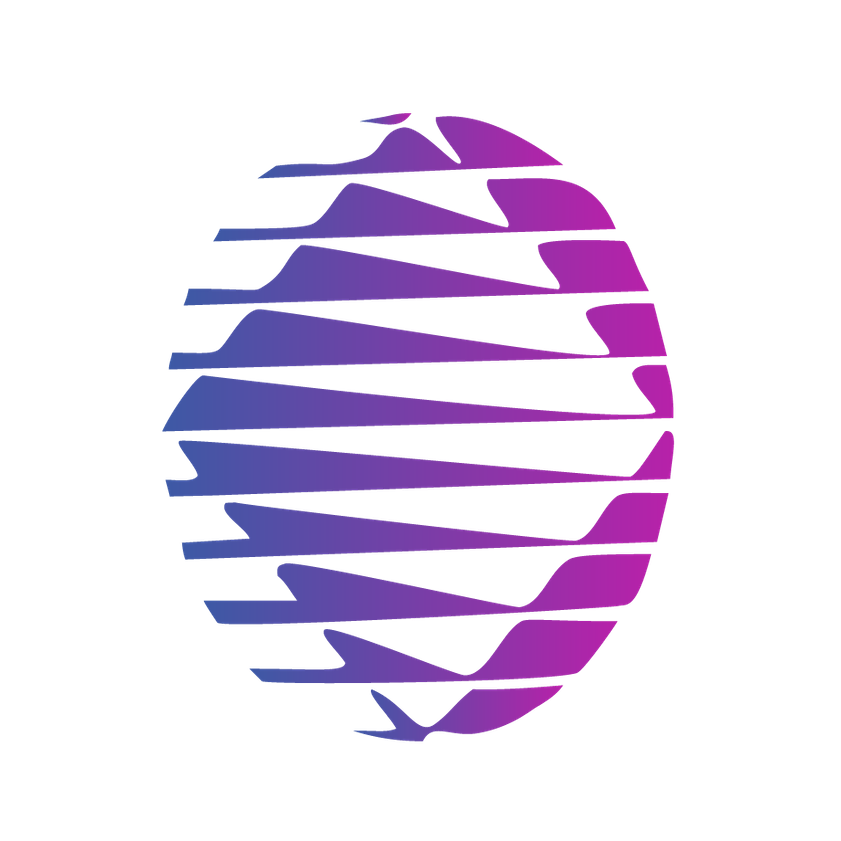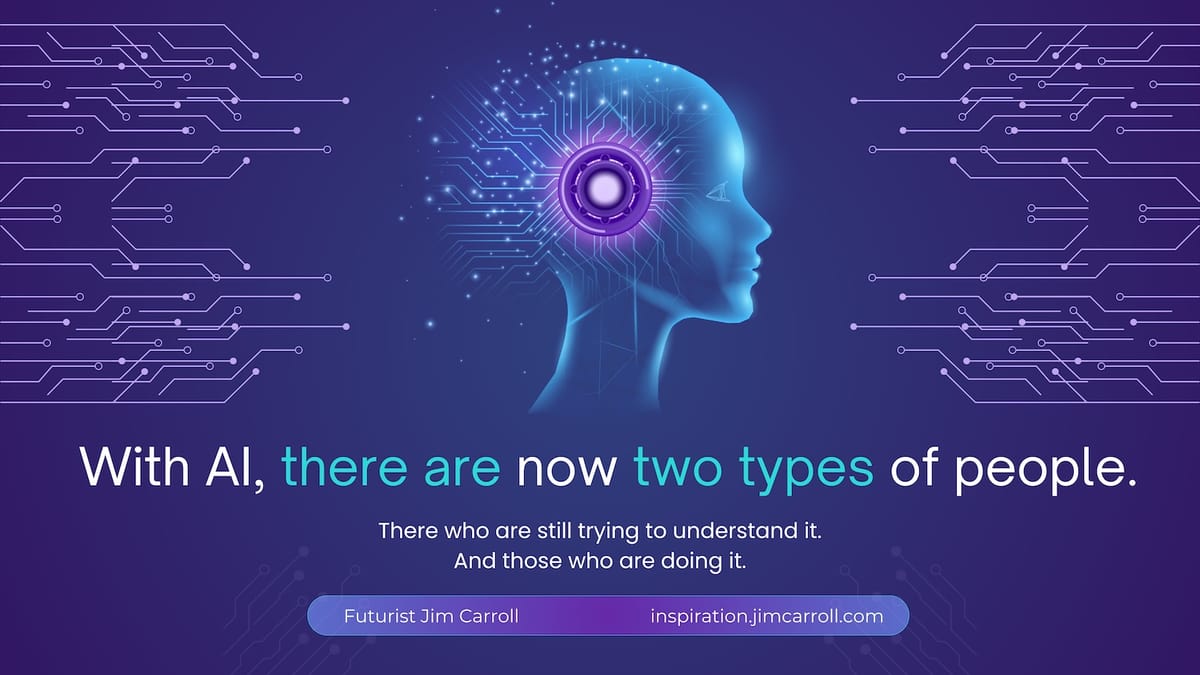"With Al, there are now two types of people. There who are still trying to understand it. And those who are doing it." - Futurist Jim Carroll
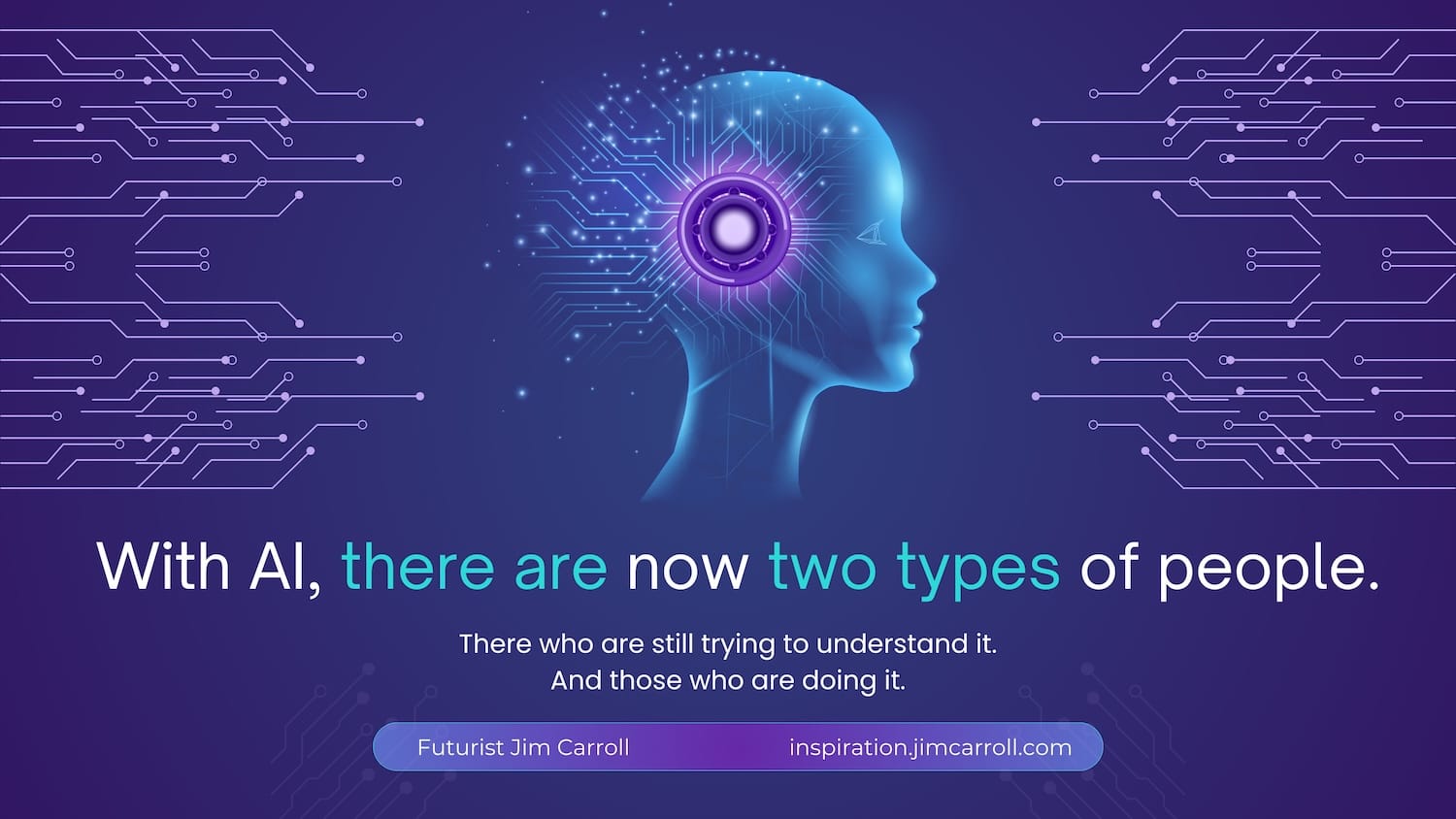
As I prepared for and then delivered a presentation on AI yesterday, I couldn't help but think about how much I've integrated various tools into my workflow regularly - and how many people listening to my talk had their minds blown by what I was doing.
The difference is stark - and I've come to see this more and more with what I do.
A few years ago, I started using this slide in my deck, with a cartoon meme that has become quite popular, often used for various purposes.
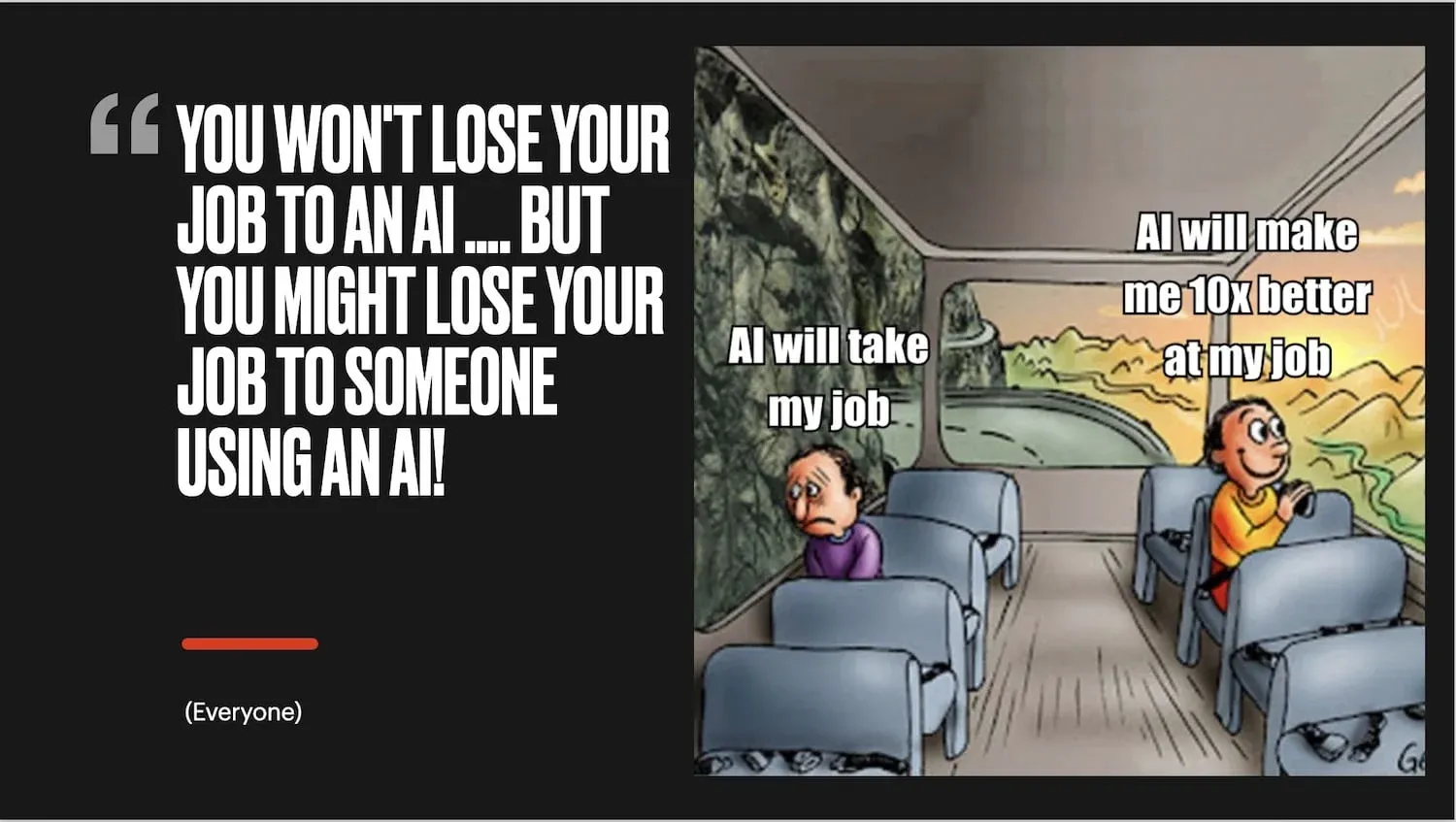
So why is this happening? Gosh, there are just so many reasons - many of which go to the core issues I've always faced with how people view the insight I share on the trends that define tomorrow.
One group operates from a place of curiosity and opportunity, while the other views AI with apprehension and uncertainty. It goes to the key point I've always raised as a futurist - some people see the future as a threat. Other people see the same future and see an opportunity. AI fits right into this mindset chasm - folks who have never been comfortable aligning themselves ot the trends of tomorrow, or even accepting those trends, are clearly stuck in the paradigms of yesterday.
This all goes right to the heart of an image I will often share from the stage. That's where we are right now with AI, skills, and knowledge.
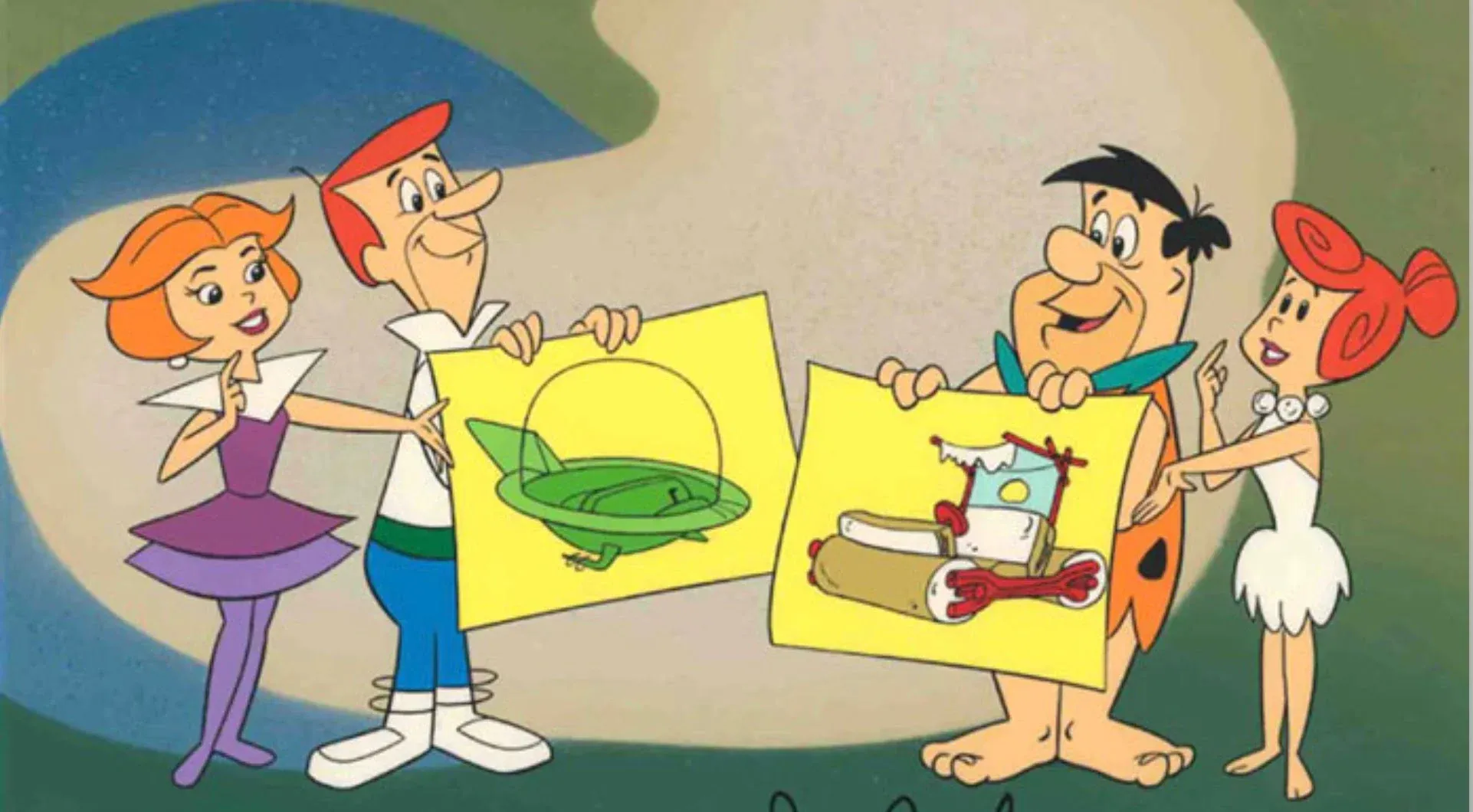
Then there is the openness that people have to learning. One group is actively creating new workflows with AI - understanding it, exploring it, and integrating it into their routines. The other are still very much stuck in old ways of doing things, and have probably never really been a big fan of change in their daily routine.
And that comes to a core point - one group is full of enthusiasm for change, and the other hates it. One group is excited for its potential; the other is fearful.
The very nature of AI presents a conundrum for all of us, and how we rationalize it determines what we do with it. One group accepts that the debate over whether AI will be good or bad understands that, just like the Internet, the debate will never be solved. The other group is busy holding themselves back as some sort of personal rebellion. One decries the growth of AI 'slop,' while the other understands that the slop is inevitable, and so we might as well figure out how to deal with it.
What it really comes down to is this - one group understands that the future is going to be profoundly impacted in massive ways by AI, while the other still is not prepared to accept what is happening.
I could go on.
Thirty years ago, I found myself very much in the midst of the same divergence of thinking as the Internet appeared on the scene. It didn't go away and came to have a profound impact on the future of all of us. Some of us aligned with it and built wonderful new careers - others dismissed it and didn't see the same opportunities.
The key thing is, right now, if you are in the second camp, you face a choice - how quickly can you become a member of the first camp?
I asked Google Gemini how you could do this. It came back with a 10-point list on how to become an AI 'Doer.' It's not a bad list!
- Reframe Your Mindset: From Threat to Tool. Consciously stop asking "Will AI take my job?" and start asking "How can I use AI to become 10x better at my job?" See it as the ultimate intern or assistant that you direct.
- Pick One Task, One Tool, One Week. Don't try to learn everything. Identify one repetitive, time-consuming task you do daily. It could be writing emails, summarizing meeting notes, or brainstorming ideas. Dedicate one week to using a single AI tool for only that task.
- Master the Art of Conversation (Prompting). Your results depend entirely on your instructions. Learn the core principles of effective prompting: provide clear Context, assign a specific Role, give explicit Instructions, and provide an Example of the desired output (CRIE).
- Go Beyond the Hype: Find Your Niche AI. While ChatGPT is the famous all-rounder, hundreds of specialized AI tools exist. Spend an hour searching for "AI tools for [your profession]". You will find powerful platforms for marketing, coding, scientific research, graphic design, and more.
- Learn by Building a Mini-Project. Give yourself a small, tangible project with a clear outcome. For example: "Use AI to generate a 12-month content calendar for my blog" or "Use AI to analyze this spreadsheet of customer feedback and identify the top three complaints."
- Automate One Simple Workflow. Explore tools like Zapier or IFTTT that connect AI with your other applications. Create a simple automation, such as "When I save an article to Pocket, have ChatGPT summarize it and send the summary to my email."
- Curate Your Learning Feed. Unfollow the fear-mongers and pundits. Instead, follow practitioners and developers on platforms like X (Twitter), LinkedIn, or YouTube who share practical tips, real-world use cases, and actionable workflows.
- Develop the "5-Second AI Check." Before starting any new task, pause for just five seconds and ask yourself: "Is there any part of this process an AI could help with?" This simple habit builds the crucial muscle memory for leveraging AI.
- Embrace Iteration and Dialogue. Never accept the first output as final. Treat your interaction with an AI as a conversation. Challenge its responses, ask it to provide alternatives, tell it what to change, and guide it toward the perfect result.
- Schedule 30 Minutes of "Play" Each Week. Block out a small, consistent amount of time on your calendar to simply experiment with a new AI tool or feature with no goal in mind. This low-pressure exploration fosters curiosity and often leads to the biggest "aha!" moments.
This last point is probably the most important! Play more! Waste time! Indulge yourself in the beauty of useless projects - because ultimately, that is how you learn and master new skills.
Whatever the case may be, recognize that right now, a vast skills gap is emerging, and you don't want to be caught on the wrong side.
Futurist Jim Carroll believes that "AI augmented" is quickly becoming a critical career success factor.
